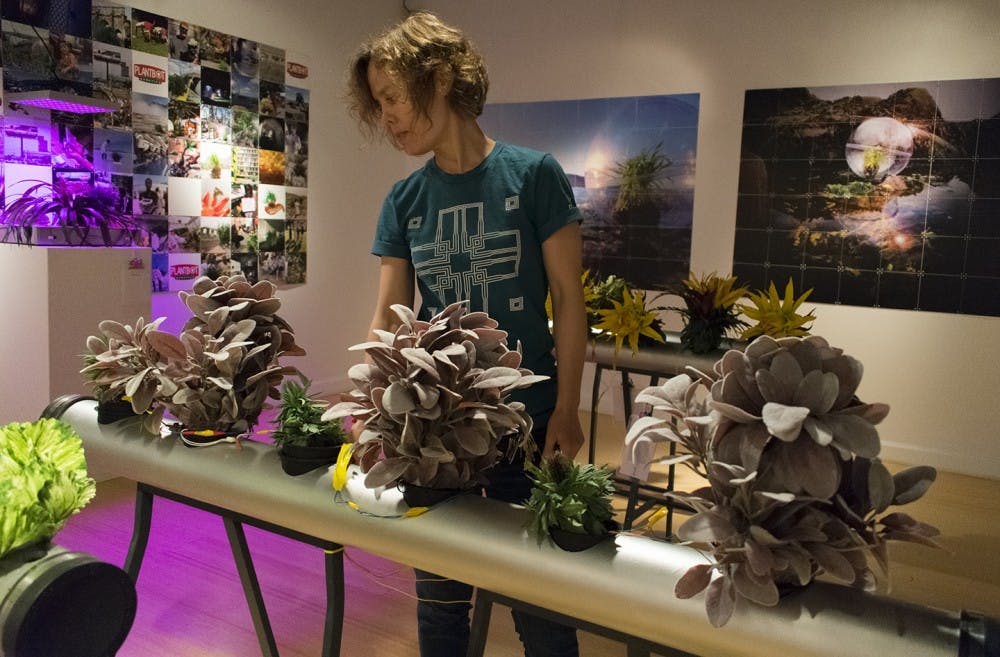A satirical take on modern agriculture has brought robot plant hybrids to USC in the hopes of sparking conversations about sustainability on campus in an exhibit called PlantBot 2.0.
Artists and educators Wendy DesChene and Jeff Schmuki created a display at McMaster Art Gallery which depicts bioengineered robot plant hybrids. The main focus of these hybrids is sustainability. The interactive experience allows viewers to touch buttons on the plants and buttons suspended from the ceiling.
The exhibit is on display until Oct. 11, when artists will return to teach a free plant bot building workshop for Campus Sustainability Month.
“They approach it with a degree of playfulness, and we felt that’s a really good way to start this conversation," said Olga Yukhno, the director of McMaster Gallery. "A lot of times people feel intimidated or not willing to talk about something that serious, especially if they don’t know that much about it."
The robot plant hybrids, engineered by PlantBot Genetics, can perform eccentric tasks that have never been seen before. For example, the Smart Swamp Weed was engineered "to dance along to the song made famous by Leonardo DiCaprio in 'Romeo and Juliet' in which the leaves sing and turn about in a repeating circular pattern." The plant also performs a rain dance to aid in returning water to dry or drought-ridden areas in South Carolina.
The gallery takes aim at a new discovery in modern agriculture referred to as genetic engineering, which is a process where scientists deliberately modify an organism's genetic material to enhance or add certain characteristics. This process is relatively new, and the artists warn of it's potentially hazardous environmental and societal impact.
Laura Kissel, director of the School of Visual Art and Design, has her interest was sparked by the "culture-jamming" characteristic of the exhibit, which brings together corporate images, slogans and logos combined with a social message.
“The messages in an art work can help us engage in important dialogue and debate about social, cultural and political life,” Kissel said.
Another one of the creations is the Monsantra PlantBot, named after the Monsanto Corporation, which is one of the largest producers and distributors of genetically modified seeds on the globe. Monsantra's appearance in the exhibit is that of a plant with monster truck-like tires on a remote-controlled robotic base.
“In this case, do we think it’s ok that the genes of animals are crossed with those of plants to create pest or chemical resistance?" Kissel said. "What might be the long-term impact on society, the environment, and human health? What are the down sides, and what are the benefits?"
Yukhno wants gallery viewers to leave thinking about the foods they eat, where they were created and what agricultural techniques were used to create them. She also enjoyed the display's highlight of superbugs and superweeds, which inherit a high tolerance to pesticides and harmful chemicals making them virtually impossible to kill, according to Yukhno.
“What consequences all these dramatic changes that we are making right now are going to have in about 20, 30, 40, 50 years," Yukhno said. "Maybe not with us, necessarily, but maybe with our children or grandchildren or the whole environment altogether."
Audrey Jones, business manager for Green Quad, helped bring PlantBot 2.0 to USC and has a personal interest in sustainability and art. She was intrigued by how cleverly interactive the exhibit is.
“It’s one of the most innovative things I’ve seen in a long time," Jones said. “I hope that it will impact students in their personal decisions ... and I hope that the impact is personal and long-lasting of awareness.”

